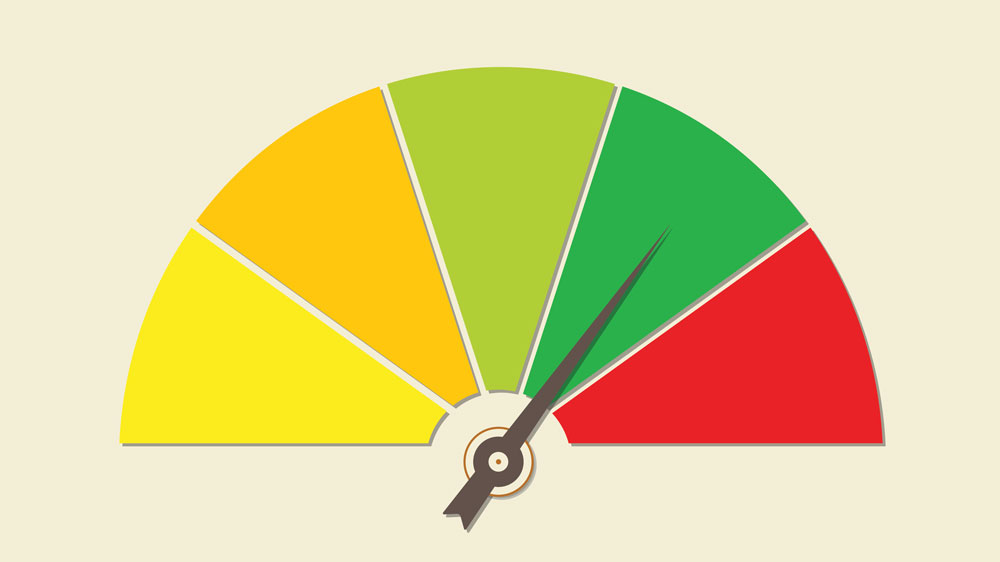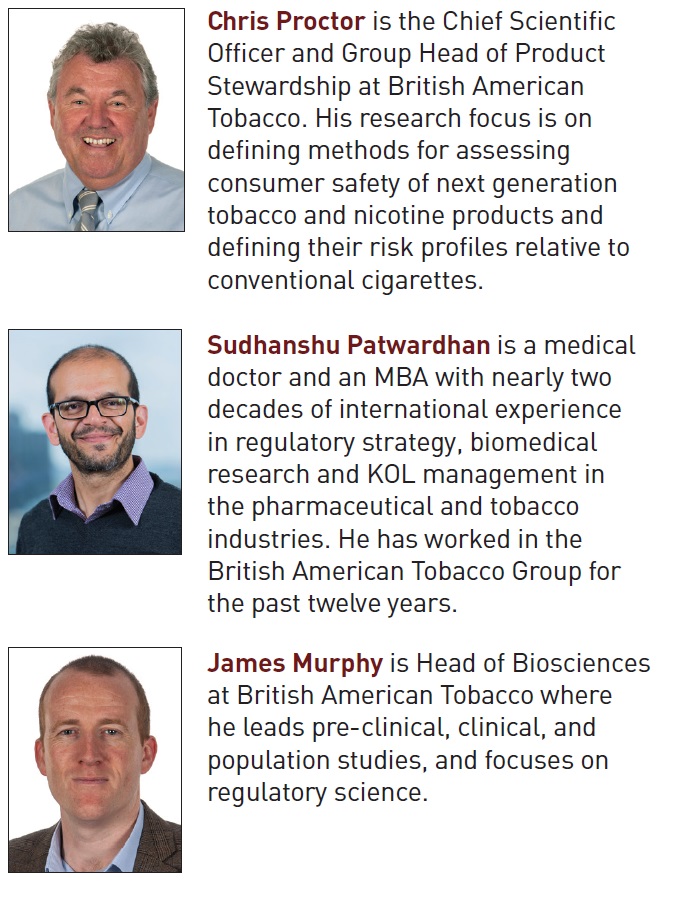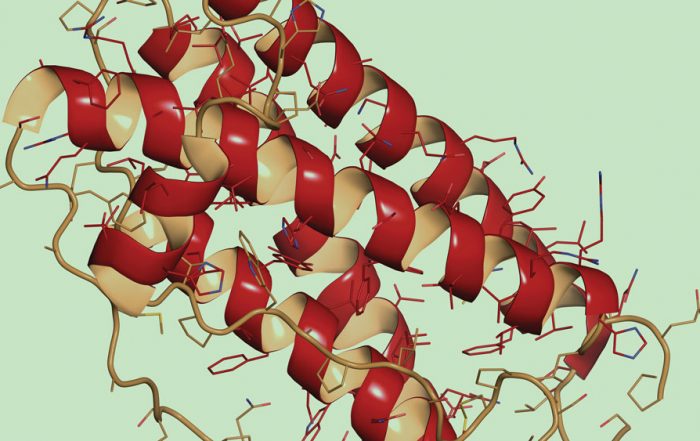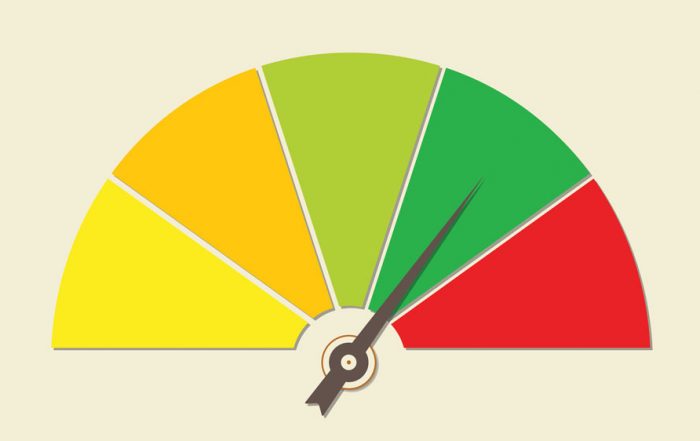
A Model Risk Continuum for Tobacco and Nicotine Products
by Chris Proctor, Sudhanshu Patwardhan, and James Murphy
The concept that not all tobacco and nicotine products present the same risks to human health has existed for some time. There is clearly a large difference in the health risks associated with cigarette smoking as compared to the use of medicinal nicotine products, such as nicotine replacement therapy. Some have attempted to describe a “risk continuum” and to fit various product categories along it. In its announcement on July 28, 2017, FDA noted “A key piece of the FDA’s approach is demonstrating a greater awareness that nicotine — while highly addictive — is delivered through products that represent a continuum of risk and is most harmful when delivered through smoke particles in combustible cigarettes.” (FDA, 2017) This paper looks at the emerging evidence base for placing newer products, such as novel Tobacco Heating Products and electronic cigarettes, on a risk continuum and concludes that currently this can only be done on a “model” or “estimated” basis grounded on toxicant emissions, toxicant exposure, and biological testing data.
 The risks for a range of serious diseases have been determined through reviews of the scientific literature by many public health bodies over many decades. Perhaps most notable are reports by the UK Royal College of Physicians, who first issued a report on smoking and health in 1962 (RCP 1962), and the Reports of the US Surgeon General, first published in 1964 (USSG 1964). Over the years, the number of diseases considered to be associated with cigarette smoking has grown and the precision of calculation of the relative risks associated with smoking has improved.
The risks for a range of serious diseases have been determined through reviews of the scientific literature by many public health bodies over many decades. Perhaps most notable are reports by the UK Royal College of Physicians, who first issued a report on smoking and health in 1962 (RCP 1962), and the Reports of the US Surgeon General, first published in 1964 (USSG 1964). Over the years, the number of diseases considered to be associated with cigarette smoking has grown and the precision of calculation of the relative risks associated with smoking has improved.
The most important data in determining health risks related to cigarette smoking are epidemiological studies, both prospective, where a group of volunteers are followed over time and any illnesses recorded, and cross-sectional, where a group of people with a particular disease are matched as closely as possible to a group without the disease, and factors in lifestyle that differ between the groups recorded. The studies show that the risks for most smoking related diseases show a dose-response where the risks rise as a result of various factors, particularly by duration of smoking but also by numbers of cigarettes smoked per day, and that relative risks reduce on smoking cessation. Other data supporting conclusions that smoking causes various diseases include data identifying toxicants in smoke known to cause disease such as cancer, and toxicological studies that use laboratory models to determine the impact of smoke on cells cultured in vitro or on animals.
This evidence was the basis of the US Institute of Medicine’s 2001 report “Clearing the smoke — the scientific basis for tobacco harm reduction” (IoM 2001) which proposed that tobacco and nicotine products that substantially reduced exposure to tobacco and smoke toxicants (termed then “PREPs” — potential reduced-exposure products) should be developed and studied to determine any reduced health risks relative to cigarette smoking.
At the other end of a proposed tobacco and nicotine products risk continuum are medicinal nicotine products, where the principle ingredient is nicotine delivered either dermally, orally, or through inhalation. Here, there is far less epidemiological evidence as to disease risk than exists for smoking because, in part, the products are medicines that were designed to be used for a short period of time as an aid to complete smoking cessation (Lee 2017). Many smoking related diseases are chronic diseases, developing in later life after years of smoking. However, despite the absence of definitive epidemiological evidence, the UK Royal College of Physicians concluded that “Extensive experience with nicotine replacement therapy in clinical trial and observational study settings demonstrates that medicinal nicotine is a very safe drug” and “There is no direct evidence that NRT therapy is carcinogenic or influences the risk of other common smoking related diseases in humans” (RCP 2007).
Another product category that has epidemiological evidence to help determine its potential place on a proposed risk continuum is Swedish snus. Much of this data comes from Sweden, where there was a substantial shift from cigarette smoking to snus use among males in the 1970s and 1980s, allowing data to be collected on the consequence of this shift on disease incidence. Known as “the Swedish experience,” the rates of smoking-related diseases in Swedish men were generally observed to fall following the switch from smoking to use of snus (Foulds et al, 2003). Snus delivers nicotine orally and without combustion, so snus users are exposed to a different profile of toxicants through a different route of exposure as compared to cigarette smokers. The data suggest that snus use does not cause lung cancer, oral cancer, or chronic obstructive pulmonary disease, although snus use was not observed to be risk-free and may be associated, for example, with an increase in risk for some forms of cardiovascular disease (RCP 2007). The advantage of the health science related to snus is that snus products generally have similar toxicant profiles as they were made against a self-imposed manufacturing and product standard. There is epidemiological evidence that other types of smokeless tobacco products, such as American moist snuff and chewing tobacco, are also reduced risk compared to smoking, perhaps unsurprisingly, as they involve oral rather than direct lung exposure, but they can have a wider potential range of toxicant emissions compared to snus.
So a framework for a risk continuum for tobacco and nicotine products can be constructed based on epidemiological and clinical data, and other scientific studies, that position cigarettes at the high risk end, nicotine replacement therapy at the low risk end, and smokeless tobacco products, because their principal route of exposure leads to little risk of respiratory diseases caused by smoking, between the two but much closer to nicotine replacement therapy than cigarettes.
But what about newer tobacco and nicotine products? The use of electronic cigarettes (e-cigarettes) is a relatively new phenomenon, and there are to date no long term epidemiological studies to determine the relative risk of their use compared to cigarette smoking or other forms of tobacco or nicotine use, simply because they have not been used and studied for long enough to determine this. In addition, there are many types of e-cigarettes on the market that result in a variety of emission profiles. Chemical studies have shown, though, that the emissions from e-cigarettes typically contain significantly fewer tobacco-related toxicants, and at lower levels, compared to cigarette smoke. Chemical studies of British American Tobacco (BAT)’s Vype ePen e-cigarette demonstrate that, in laboratory testing, the aerosol generated contains (Margham 2016) on average between 82-99% lower levels of tobacco-related toxicants as compared to a scientific reference cigarette smoke. In addition, toxicological studies conducted by BAT suggest emissions from the Vype ePen test e-cigarette induce a substantially lower level of biological activity in laboratory tests compared to cigarette smoke (Haswell et al, 2017). For example, it is well known that cigarette smoke is mutagenic, whereas emissions from the tested Vype ePen e-cigarette were not observed by BAT researchers to cause mutagenicity in model toxicologic systems in laboratory testing (Azzopardi et al, 2016).
Public Health England, a UK government body, concluded that “the current best estimate is that e-cigarettes are around 95% less harmful than smoking” (PHE 2015), and the Tobacco Advisory Group of the UK Royal College of Physicians state that “the hazard to health arising from long-term vapour inhalation from the e-cigarettes available today is unlikely to exceed 5% of the harm from smoking tobacco” (Key Recommendations, RCP 2016). However, both bodies warn that more long-term research is needed and that product standards should be developed because e-cigarette designs and liquids vary widely and not all products may fit with these conclusions. Currently, however, given that the risks posed by e-cigarettes are not fully characterised, placing them on a continuum of risk is largely a matter of educated conjecture based on toxicant emissions, toxicant exposure, and biological testing data. This situation will improve as foundational datasets that include long term clinical studies are published on certain e-cigarettes, and will help position the e-cigarettes studied on the risk continuum, noting that other e-cigarettes may present a range of risks.
A further potential category emerging is that of Tobacco Heating Products, where tobacco is heated rather than burnt. The concept of heating tobacco is not new, and was pioneered by R J Reynolds in the 1980s in a product called Premier, and later as Eclipse, where the tobacco rod was heated by a carbon tip that was lit, but did not burn down. The same concept, but using small electrically heated ovens to heat the tobacco, is being used in the design of a newer generation of Tobacco Heating Products (such as BAT’s glo™ Tobacco Heating Product, which heats the tobacco to around 240 degrees C). glo™ from BAT and iQOS™ from PMI have recently gained considerable tobacco market share in Japan and are now being made available in other countries.
Studies conducted by BAT researchers on BAT’s glo™ tobacco heating product found that glo™ tobacco vapor contains significantly fewer and lower levels of toxicants compared to reference cigarette smoke (Forster et al 2017), though the numbers of tobacco-related toxicants are typically higher in these products than in e-cigarettes (Murphy et al 2017). However, perhaps even more so than with the evidence base regarding e-cigarettes, the risks posed by Tobacco Heating Products are as yet not well characterised and placing such products on a continuum of risk is again largely a matter of educated conjecture based on toxicant emissions, toxicant exposure, and biological testing data.
In addition, there are hybrid Tobacco Heating Products such as i-Fuse™ from BAT and Ploomtech™ from JTI which contain tobacco that is heated very gently by passing aerosol generated from a liquid formulation over the tobacco. For iFuse™, researchers at BAT found that this novel hybrid tobacco product maintains a toxicant profile similar to the comparator vapor product, with significantly lower levels of some key toxicants in comparison with cigarette smoke (Poynton et al 2017).
Criteria for positioning products on a model risk continuum related to individual risk
For products that have been used for many years and where there are epidemiological data, it is reasonably easy to place these on a risk continuum related to individual health risk. This is true for cigarettes and snus. This is reasonably true for other oral tobacco products such as traditional chewing tobacco and pipe tobaccos and less true for cigars. Risks for diseases such as lung cancer are strongly related to inhalation of smoke into the lungs, so products such as smokeless tobaccos and NRT are by their nature likely to pose substantially different risks to cigarette smoking. McNeil and Munafo (McNeil 2012) developed a model risk continuum that reflects this.
For relatively new products, it is possible to look at their key characteristics, particularly toxicant emissions and in vitro toxicological responses to their aerosols, and estimate where they might fall on a model risk continuum. However, caution should be taken in trying to assess risk on the basis of toxicant emissions. The dose response effects of each of the toxicants measured is not well known, and the dose response curves of the key diseases are relatively poorly described. In addition, particularly in the case of e-cigarettes, a very wide range of products are available and, in the absence of product standards, these may carry a range of emission profiles and different risks depending on the product. In short, absent epidemiological evidence, and knowledge of the range of potential toxicant exposures from products across any particular category, placing newer, novel products on a risk continuum presents substantiation challenges.
Criteria for positioning products on a model risk continuum related to population risk
Society concerns itself when setting public policy with a more holistic view of the risks of using certain products. This is especially true for tobacco and nicotine products because they are addictive, and because the most widely used product, the cigarette, is associated with large risks to a wide range of diseases. So the impact of a product on initiation and cessation, and the potential air quality impact, all need to be considered. Nutt et al, using the methodology of multi-criteria decision making by an expert panel, have taken a broader set of criteria when evaluating tobacco and nicotine categories. In this evaluation, cigarettes clearly were evaluated as the most harmful product, and were scaled to a score of 100. Small cigars scored 64, and pipes 21, and all other products assessed, including smokeless tobaccos and e-cigarettes, scored less than 15. The authors concluded “Cigarettes are the nicotine product causing by far the most harm to users and others in the world today. Attempts to switch to non-combusted sources of nicotine should be encouraged as the harms from these products are much lower.” (Nutt et al, 2014)
Risk continuum or risk cliff?
Attempts to assess the range of risks associated with different tobacco and nicotine products from the perspective of both risks to the user and risks to the population show cigarettes and medicinal nicotine at different ends of the spectrum, and also show a large difference between tobacco products that are combusted and their emissions inhaled, and certain tobacco and nicotine products that are not combusted. Given this, is it more appropriate to consider there to be a model risk cliff, with cigarettes on the top of the cliff with NRT, snus and, although reduced risk substantiation is lacking, likely well-designed e-cigarettes and Tobacco Heating Products at lower elevations, still with some remaining risks but well distinguished from cigarettes?
Conclusions
If accurate and not misleading, developing a graphic model for depicting differences in both population and individual risk of different categories of tobacco and nicotine products may serve a useful purpose, both to support regulators in the assessment of regulatory approaches to the different product categories, and to inform potential users of choices related to long term health consequences of using the products. However, for many products — such as e-cigarettes and Tobacco Heating Products — reduced risk substantiation currently is lacking such that placing such products on a risk continuum can only be done on a “model” or “estimated” basis grounded on toxicant emissions, toxicant exposure and biological testing data. Moreover, while foundational datasets that include chemical, physical, toxicological, and clinical data, are likely to be completed on specific e-cigarettes and specific Tobacco Heating Products, the estimated risks associated with these products may not necessarily apply to all products in each category. That said, there is an emerging consensus judgment that, notwithstanding the evidence gaps, cigarettes are likely to be much more dangerous than tobacco and nicotine products that do not involve the combustion of tobacco or do not involve inhalation of smoke.
References
US FDA, FDA News Release, FDA announces comprehensive regulatory plan to shift trajectory of tobacco-related disease, death, July 28 (2017).
Fletcher, C. M. “Smoking and health: report of the Royal College of Physicians.” London: Pitman Medical (1962).
US Department of Health and Human Services. “Smoking and health.” Report of the Advisory Committee to the Surgeon General. Washington, DC: US Government Printing Office (1964).
Bondurant, Stuart, et al., eds. Clearing the smoke: assessing the science base for tobacco harm reduction. National Academies Press (2001).
Lee, et al., “A systematic review of possible serious adverse health effects of nicotine replacement therapy,” Arch Toxicol (2017) 91:1565–1594.
Tobacco Advisory Group of the Royal College of Physicians “Harm reduction in nicotine addiction Helping people who can’t quit.” Royal College of Physicians (2007).
Foulds, Jonathan, et al. “Effect of smokeless tobacco (snus) on smoking and public health in Sweden.” Tobacco control 12.4 (2003): 349-359.
Margham, Jennifer, et al. “Chemical composition of aerosol from an E-cigarette: A quantitative comparison with cigarette smoke.” Chemical research in toxicology 29.10 (2016): 1662-1678. British American Tobacco tested and compared emissions from a Vype ePen e-cigarette and a reference conventional cigarette in laboratory tests. The emissions were tested to measure constituents in each puff that have been listed as harmful or potentially harmful by the FDA, the World Health Organization, or Health Canada.
Haswell, Linsey E. et al. “Reduced Biological Effect of E-Cigarette Aerosol Compared to Cigarette Smoke Evaluated in Vitro Using Normalized Nicotine Dose and RNA-Seq-Based Toxicogenomics.” Scientific Reports 7 (2017): 888. PMC. Web. 12 July 2017.
Azzopardi, David, et al. “Electronic cigarette aerosol induces significantly less cytotoxicity than tobacco smoke.” Toxicology mechanisms and methods 26.6 (2016): 477-491.
“E-cigarettes: An Evidence Update,” Public Health England (2015).
Tobacco Advisory Group of the Royal College of Physicians. “Nicotine without smoke—tobacco harm reduction.” Royal College of Physicians (2016).
Forster M, et al. “Assessment of tobacco heating product THP1.0. Part 3: Comprehensive chemical characterisation – harmful and potentially harmful aerosol emissions.” Reg Tox Pharm (Submitted to journal April 2017).
Murphy J et al. “Assessment of tobacco heating product THP1.0. Part 9: The quantitative placement of a range of next generation products on the risk spectrum relative to cigarettes via a pre-clinical assessment of their emissions.” Reg Tox Pharm (Submitted to journal April 2017).
Poynton, Simon, et al. “A novel hybrid tobacco product that delivers a tobacco flavour note with vapour aerosol (part 1): Product operation and preliminary aerosol chemistry assessment.” Food and Chemical Toxicology (2017).
McNeill, Ann, and Marcus R. Munafò. “Reducing harm from tobacco use.” Journal of Psychopharmacology 27.1 (2013): 13-18.
Nutt, David J., et al. “Estimating the harms of nicotine-containing products using the MCDA approach.” European addiction research 20.5 (2014): 218-225.
Update Magazine
July/August 2017










